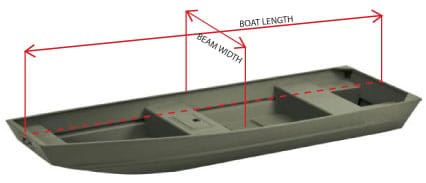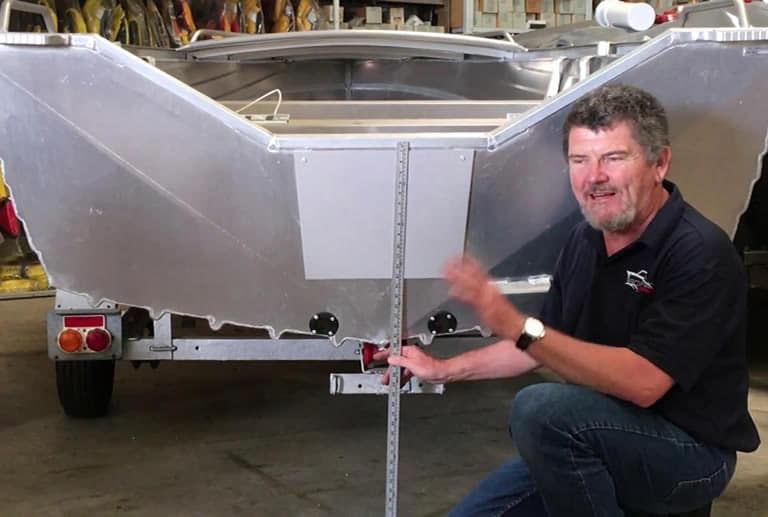Contents
Why you need to to know your boat’s measurements
We have previously covered the importance of knowing how much your Jon boat weighs and your Jon’boat’s weight capacity. But, knowing your Jon boat’s dimensions are just important for a variety of reasons.
Here are some of the more important reasons for having your Jon boat’s dimensions to hand:
- Safe and legal towing. State and Federal legislation specifies the length of vessel that can be safely towed by a variety of vehicle classes. You will need to ensure that you remain within the law.
- Loading and unloading. We have previously shown how to effective load and unload a your boat on a trailer. While doing this you should know the length and width of your boat to avoid collisions with fixed objects.
- Procuring a suitable trailer. You will need to have your boat width and length on hand of you are shopping for a new trailer to ensure it is correctly sized.
- Attaching an outboard motor. You need to know your Jon boat’s dimensions before acquiring an outboard motor with the correct shaft length for your transom.
- Acquiring the right anchor. Calculating the correct length and thickness of rope and chain needed for your anchor.
- Getting the correct boat accessories. Purchasing boat accessories like covers.
- Planning and pricing storage of your boat.
- Wiring your Jon boat. You need to know the dimensions of your boat so you have the correct equipment for wiring your Jon (like wire length) as we demonstrated how to do here.
- Making upgrades. Undertaking renovations and upgrades like installation of seating or a deck.
I have my manufacturer’s handbook. Do I still need to measure my boat?
Do you still need to measure your boat if you have the boat’s handbook?
The short answer is … Yes!
Most handbooks are written to cover a range of different sized boats that have similar or generic characteristics.
Manufacturers save money by incorporating several different models into the one handbook. This can cause problems with incorrect dimensions and design plans being given not to mention the confusion it creates for the reader.
What’s more when a manufacturer upgrades or changes the design of a vessel they will often use the same specs from the handbook for the previous model, simply changing the model number. Sometimes they don’t even do that.
Therefore don’t be surprised if there are slight (or even large) differences between what the handbook states and the actual fabrication and design of your boat.
These differences can lead to minor or major discrepancies between the generic dimensions in the handbook and the real-world dimensions of your Jon boat.
Measuring your boat yourself is the only way to get the accurate dimensions of your vessel.
The 3 Key Dimensions Of A Boat. How To Measure Them & Why You Need To Know Them
Very experienced mariners may be able to size a boat by just looking at it but for the rest a much more methodical approach is needed.
However, even experienced boat owners can get it wrong when using guesswork.
Guessing, when it comes to your boat’s measurements, can cause a lot of problems later down the line when you need the specific and accurate dimensions of your boat.
To ensure the measurements of your Jon are accurate you need to measure it. There is no way around this.
Luckily it is a very easy thing to do.
But, before we go into the actual process of measuring your boat you need to be aware of which parts of the boat you need to measure.
Here are the key dimensions of a Jon boat and how to measure them:
- Length. Length is measured from the tip of the front of your Jon, to the rear of your boat. Measure from the middle of the bow to the center of your transom down the length of your Jon. You can check it at two points along the top and bottom of your Jon boat to ensure your measurement is correct.
- Width. Width is measured at the bottom of the boat from one side of the boat to the other. Width is normally measured at the back of the boat near the stern.
- Beam. The beam of a boat is different from the width and you should not confuse the two. The beam is the widest point on the boat and can located anywhere along the hull. It is usually towards the rear on Jon boats or in the middle. Remember that the beam is distinct from your boat’s width because the beam is the widest part of the boat.

Length is measured from tip to tip.
Width is measured from side to side near the rear of the boat.
Beam refers to width at the widest part of your boat.
Now you know where to measure your Jon boat let’s look at how these measurements are often used in everyday language.
How to understand Jon boat measurement terminology – it’s all in the name
You may have heard folks at the ramp, marina or in the dealership talk about having a 1436 or 1230 boat. This is distinct boat terminology that is widely used among Jon boat enthusiasts.
When numbers such as 1436 or 1230 are mentioned they are simply an abbreviation of the length and width dimensions of the boat.
below are two examples of how these abbreviations are used.
A boat which is described as a 1436 has:
- A length of 14 feet.
- A width at its bottom of 36 inches.
A boat which is described as a 1230 has:
- A length of 12 feet
- A width at its bottom of 30 inches.
Be aware that this refers to the length and width of the boat not the length and beam of the boat!
The length in feet used in boat abbreviation terminology may also be rounded to the nearest whole number as Jon boats often come in lengths that differ from a whole number. A good example of this is Lowe’s Olympic Jon L1852MT.
The Olympic is referred to as an 1852 (meaning 18 foot length and 52 inches width) and is marketed as an 18 footer. However, in reality the Olympic only has a length of 17 foot 9 inches (3 inches short of a 18 foot). Hence, as with convention of rounding up the length, this boat gets the 1852 used in its name.
Jon boats come in a variety of widths. The most recognized widths are 32″, 36″, 40″, 42″, 46″, 48″, 52″.
If you are planning on decking your Jon boat, widths of 36 inches and below are simply too narrow to safely recommend doing it.
Other boat measurements you should know
- Length overall (LOA). This is usually the same as the length and is measured from the tip of the bow to the center of the stern.
- Waterline length. This measurement refers to the length from the point where water touches the bow of the hull to where it touches the stern of the hull.
- Freeboard length. This equals the distance between the waterline and the tip of the bow.
- Draft. The draft is the distance between the waterline and the lowest point of the hull. Hence, with there flat bottom Jon boats are considered shallow draft boats rather than deep draft boats (read more on that here).
- Freeboard and draft can be combined to provide the total height of the boat.
You should also keep in mind that the load on your boat will affect certain measurements like the freeboard, draft and waterline length.
If you are keen or undertaking a project like decking your Jon boat, where additional weight will be added to the boat, compare measurements with the boat empty and when it is carrying a normal load.
There is no need for specialist equipment to measure your Jon boat
Many new boaters think that there are specialized pieces of kit used to measure a boat.
Do you need to buy any specialist measuring devices to measure your Jon boat?
No!
A simple tape measure is more than adequate.
How To Measure A Boat – video instructions
The following video is a demonstration of how to measure a speedboat but don’t let this put you off. The same principles for measuring this boat apply to every other boat – including your Jon boat.
You’ll quickly see how easy it is to get the accurate dimensions of your Jon.
Summary – How To Measure A Jon Boat Correctly
Gaining a good familiarity with the dimensions of your Jon boat is essential for understanding how to handle your boat and work on it while you stay legal and safe. We therefore encourage you to get out the tape and measure your boat ensuring you take measurements along all the key points.
You need to measure:
- The boats’ length. Measure from the middle of the transom at the stern (back part) of the boat, to the tip of the bow.
- The boat’s width. Measure the stern (back end of the boat) from one side to the other.
- The boat’s beam. Measure the widest part of the boat (see the article how to measure the beam of a boat).
If you want detailed measurements of your boat you will need to also measure:
- Waterline length. Lets you determine hull speed, amount of bottom-paint needed, how much water is displaced.
- Freeboard length. Will allow you to work out how much weight your boat can carry.
- Draft. Knowing the draft of your boat will keep you out of dangerously shallow waters (not a problem for Jon boats) and out of very deep waters (sometimes a problem for Jon boats especially in bad weather). Read can Jon boats go in the ocean to see the problems shallow draft vessels encounter in deep waters.
- Overall height. To obtain your boat’s overall height simply add the freeboard length number to the draft number.
Consideration of the effect of loads is always important when planning renovations. It also gives you a working knowledge and understanding of the draft, waterline length and freeboard measurements of your boat.
It can be tempting to be over-ambitious with projects like decking and storage when customizing a oat, especially when customizing a Jon boat, so having precise measurements will help you understand the capacity and capabilities of your Jon boat.

